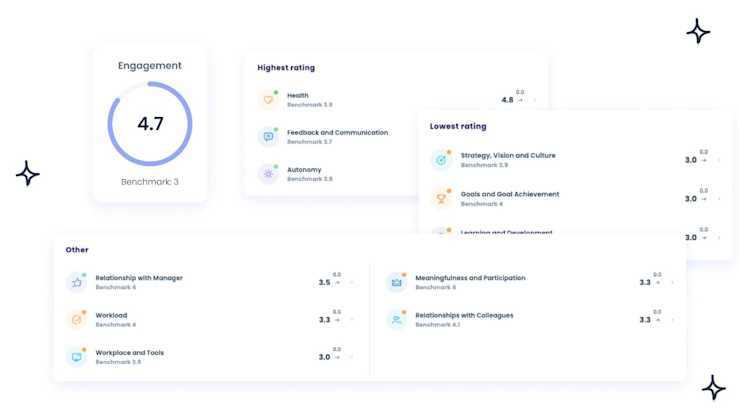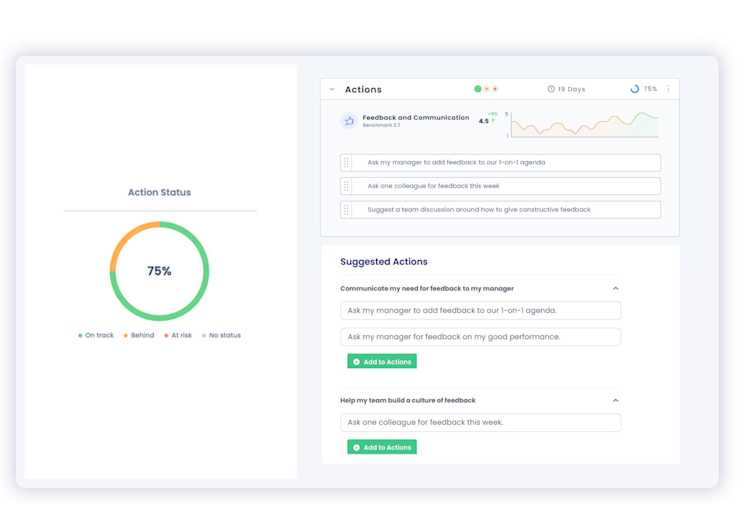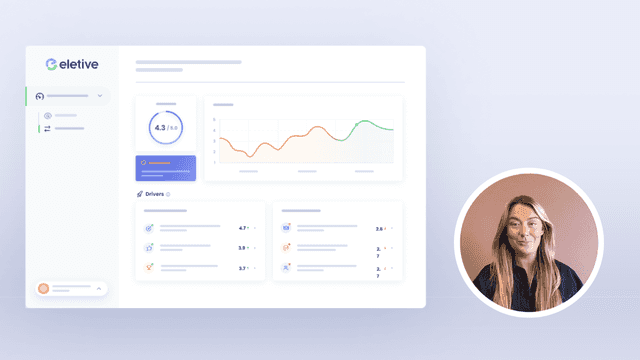Employee engagement is quite the buzzword at the moment, and understandably so. What company would not want engaged employees who show up to work with passion, purpose, and energy? Engagement, simply put, is good for business.
And yet, 85% of employees are not part of that coveted group. According to the Gallup report State of the Global Workplace, an average of only 15 percent of employees are engaged in the work they do. Gallup defines engaged employees as:
"those who are involved in, enthusiastic about, and committed to their work and workplace"
It's obvious that it will have serious repercussions for the business if only 15% of the workforce actually feels this way.
Related reading: Employee engagement survey questions – what to ask and why
In this article, we'll have a closer look at 8 of the most important benefits of employee engagement – and how to drive engagement and wellbeing in your organisation.
Table of contents
Increased productivity and greater profitability
Reduced sick leave and less long-term sickness absence
A strong employer brand
Employees become advocates
Increased staff retention
Higher customer satisfaction
Enhanced teamwork and collaboration
Reduced workplace accidents and safety incidents
1. The impact of employee engagement on productivity and profitability
Employee engagement is more than just a buzzword. It's the driving force behind successful organisations, fuelling productivity and profitability.
Understanding the correlation between engagement and productivity
A closer look at various studies reveals that employee engagement isn't merely an abstract concept; it has tangible effects on business performance. For instance, Gallup found out that highly engaged teams are 21% more productive compared to their less-engaged counterparts.
This increase in output can be traced back to several factors inherent in an engaged workforce: Engaged employees take ownership of their tasks leading to increased efficiency; they also display creative problem-solving skills which foster innovation within the organisation.
How engaged employees contribute to greater profitability
A rise in profits comes from multiple sources like reduced turnover rates due lower attrition amongst satisfied workers who feel emotionally invested towards achieving company goals thus saving costs recruitment training new hires over time.
2. Reduced absenteeism
The role of employee engagement in combating absenteeism is becoming increasingly clear. By fostering an environment that promotes involvement and commitment, businesses can significantly reduce instances of sick leave.
This approach tackles preventable mental health issues such as work-related stress head-on, addressing the root cause rather than just responding to symptoms.
How does this strategy function? Let's delve into it.
The role of mental health in workplace absenteeism
Mental health problems are one of the primary culprits behind workplace absences. Stress related to job demands or poor working conditions not only leads to short-term leaves but also contributes towards long-term illnesses if left unchecked.
Just imagine - when your employees feel overwhelmed with their workload or underappreciated by management, they're more likely to call in sick or even consider leaving altogether.
It's important then that companies take proactive steps towards promoting positive mental wellbeing at work. You can do this with Eletive’s employee wellness survey’s feature.

Strategies for reducing sick leave through increased engagement
A key strategy here involves open communication between management and staff members about expectations, progress updates and any concerns regarding their roles. This transparency builds trust within teams thus boosting satisfaction levels among employees while simultaneously decreasing chances for burnout - a common trigger behind prolonged sick leaves.
In addition, regular check-ins on individual emotional states through modern tools like pulse surveys provide managers real-time insights into team member feelings thereby enabling them to respond promptly to potential issues before they escalate into major problems resulting in time off from work.
Providing training opportunities and career development plans helps keep people motivated and engaged - when they see future prospects within the company, they are less likely to suffer from demotivation and disengagement, both of which could eventually manifest in the form of frequent days taken off.
3. Strengthening your employer brand
A strong employer brand is a magnet for top talent.
However, it's not just about crafting an attractive image through marketing efforts; the secret ingredient lies in employee engagement and satisfaction.
The importance of transparency brought by social media
In today's digital landscape, transparency has become non-negotiable when building your employer brand. Websites like LinkedIn and Glassdoor have enabled employees to express their views on the workplace, both positive and negative.
This makes fostering positive workplace sentiments crucial as these voices are shaping public perception of what it’s like working within your organisation.
How happy employees boost your employer brand
Your most powerful tool in enhancing the reputation of being an excellent place to work?
A satisfied workforce.
Engaged employees feel valued which translates into them speaking positively about their jobs internally with colleagues or externally.
Gallup research found that teams with low engagement typically experience turnover rates that are 18% to 43% higher than those observed in highly engaged teams.
This indicates happier staff members who are unlikely leave due dissatisfaction disengagement
This creates a virtuous cycle: contented workers attract other talented individuals seeking similar job satisfaction leading towards further enhancement company's reputation as desirable place work.
By utilising Eletive, Croisette facilitated meaningful dialogues between their employees and managers, effectively mitigating burnout, stress, and illness. Discover how they achieved this in the video provided below…
4. Transforming employees into advocates
One often overlooked advantage of employee engagement is the transformation of employees into advocates.
This shift doesn't just enhance performance within office walls; it also bolsters your brand's reputation in wider circles.
The power of word-of-mouth marketing from engaged employees
A strong recommendation from a trusted source can be more impactful than any advertising campaign.
When an engaged employee shares their positive experiences at work, they're essentially endorsing your company to everyone in their network.
This kind of advocacy isn’t something you can purchase - it’s earned through creating an engaging workplace environment where people feel valued and connected to the mission. It goes without saying that this form marketing has immense potential for increasing brand visibility and attracting new talent or customers.
A good metric to track is your employee net promoter score (eNPS); Advice on how to do that here.
Impact on business growth when employees act as ambassadors
Beyond raising awareness about your organisation, having ambassadors among your staff members can directly influence business growth too.
Think about how many potential clients exist within each team member's personal networks - all these individuals could potentially become interested in what you offer based on a single conversation.
Your employees' recommendations carry weight: They have first-hand experience working with you and understand exactly what makes your products or services stand out.
Potential recruits will trust current staff over corporate messaging: An honest account from someone who works there already carries far more credibility than job adverts alone.
New leads may come naturally: If existing personnel enjoy their roles so much they want to talk positively outside work then chances are others might want to get involved too (either as consumers or candidates).
Tactics for fostering employee advocacy through engagement
Fancy turning every member into a raving fan? Here’s how:
Create an inclusive culture: Make sure everyone feels heard and appreciated - when people believe voice matters then likely speak up favourably on behalf elsewhere.
Maintain open lines communication : Regular feedback sessions provide opportunities to address concerns and celebrate achievements keeping morale high encouraging further word mouth promotion.
Leverage recognition reward schemes : Acknowledge those go above beyond advocate whether online offline platforms incentives like these help keep momentum going long term .

Increase diversity and inclusion
5. Retaining staff
When people are engaged in and enjoy their work, they are less likely to leave. High employee engagement correlates with a reduction in staff turnover, which is something that has a direct impact on your business's bottom line.
Research by the Society for Human Resource Management (SHRM) indicates that a full-time employee's average replacement cost is somewhere around six to nine months' salary. For example, replacing an employee with a salary of $60,000 per year will mean approximately $30,000 to $45,000 in recruiting and training costs.
6. Higher customer satisfaction
Engaged employees are more likely to go the extra mile to ensure customers' needs are met, leading to increased customer satisfaction and loyalty.
Satisfied customers are more likely to become brand advocates, promoting the company's products or services, ultimately contributing to long-term business growth.
7. Enhancing teamwork and collaboration
In a highly engaged workforce, employees work together seamlessly, supporting each other to achieve common goals.
Collaboration thrives, enabling teams to overcome challenges and deliver exceptional results.
By prioritising team-building activities, cross-functional projects, and fostering a sense of camaraderie, organisations can cultivate a culture of collaboration that drives success.
You can use Eletive to create team action plans. Here’s an example…

8. Reduced workplace accidents and safety incidents
Engaged employees are more attentive and committed to following safety protocols, resulting in fewer accidents and incidents.
A safe working environment boosts employee morale, while reducing downtime and costs associated with injuries or property damage.
How to measure employee engagement
An increasing number of HR managers and business leaders are becoming aware of the business impact of employee engagement. This means that measuring and improving it has moved to the top of the agenda.
From one big yearly survey – to agile, adaptive pulse surveys
Historically, employee engagement was often measured in one, massive, yearly survey. The feedback loop would take months, as the results had to be analysed, compiled, and reported on before it was finally time to act on them. But in today's fast-moving work life, this method has become outdated.
Instead, businesses now turn to modern and agile employee survey tools, with pulse functionality and real-time analytics to monitor and drive employee engagement and wellbeing.
How Eletive can help you measure and drive employee engagement
Eletive is a modern People Success Platform. We give you everything you need to build a workplace where your people can thrive and perform at their best.

SMART SURVEYS
Our adaptive machine-learning algorithm creates smart surveys for maximum impact. Questions and advice are developed by psychologists and based on the latest research. Benchmark employee survey data against your industry or our database.
PERFORMANCE MANAGEMENT AND AGILE GOALS
By bringing 1-on-1 meetings, OKR planning, and SMART goals into one unified platform, we make it easy for you to align around common processes and goals.
SELF-LEADERSHIP AND ACCOUNTABILITY
Our unique emphasis on self-leadership changes the organisational dynamic and empowers everyone to help build a great company culture – together.
Interested in how your business could benefit from a modern tool for employee engagement surveys? Talk to one of our specialists!

























